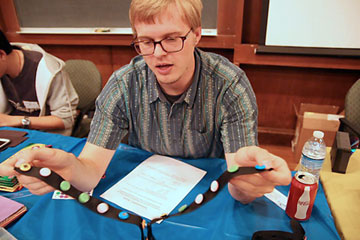
Graduate Student Taylor Canady Receives Carnegie Science Award
By Jocelyn Duffy
PITTSBURGH—When Taylor Canady took biology in high school, he found the class to be pretty boring — a lot of lectures and not a whole lot of fun. When he got to college at the University of New Mexico and saw his professors bring lecture material to life in the lab, he realized that science could be really exciting.
Now a doctoral student in Carnegie Mellon's Department of Chemistry, Canady is making sure that young students get to see just how exciting science can be. In recognition for his work, Canady has been named the 2014 recipient of the Carnegie Science Award's University/Post-Secondary Student Award. The awards are given by the Carnegie Science Center in Pittsburgh to recognize and promote outstanding science and technology achievements in western Pennsylvania.
Although he is busy conducting research on the biological functions and applications of nucleic acids in the labs of Chemistry Professor Bruce Armitage and Associate Professor of Chemistry and Biological Sciences Marcel Bruchez, Canady frequently participates in the activities of DNAZone, the outreach program of the Center for Nucleic Acids Science and Technology (CNAST) at Carnegie Mellon. Through the program, he volunteers to give science demonstrations to students from kindergarten to high school.
"Taylor is a great example of a student who has a great sense of responsibility. He knows the impact science can have on the community." said Chemistry Professor Catalina Achim, one of the coordinators of DNAZone.
"Creativity and innovation solve scientific problems. I want students to see that I'm not that different from them. I want to let them know that no matter what their circumstances may be, they can become scientists," said Canady. "Our culture perpetuates an image that it's mostly Einstein-esque individuals who can solve hard physical or natural problems. This is simply not true."
During his time as an undergraduate, Canady would often use teaching kits and activities created by other people to help younger students learn about different topics in science. When it came time to teach about his area of expertise—nucleic acids—he decided he would develop his own kit. With support from DNAZone, Canady and Chemistry doctoral student Genoa Warner created a DNA kit. The kit provides a physical model that students can use to understand how chemical parts come together to form a DNA molecule. Ribbons represent the backbone of DNA, pairs of buttons and magnets represent the nucleobase pairs of DNA, and Velcro and magnets represent the chemical bonds that connect the nucleobases with the DNA backbone. Students can "write" their own DNA sequence by attaching the buttons and magnets to the Velcro, and then use basic rules to transcribe the sequence to another ribbon. When the DNA molecule isn't assembled correctly, the students see how errors can make the molecule unstable - much like what happens in genetic diseases.
"If younger students can understand some basic science concepts, like nucleobase pairing, base sequences and structure design, they can really start to build some interesting things. It has been really exciting to see the complicated structures they are able to make and listen to the complex questions they ask," said Canady.
"Teaching young students about how molecules are structured and how they interact is challenging because of the molecules' very, very small size. Having a physical model of molecules to handle and play with helps the students understand that size aside, molecules are just Lego pieces that fit together according to rules. The DNA kit that Taylor and Genoa created is such a physical model," said Achim.
The DNA kits became part of the Lending Library of Kits supported by DNAZone. The library makes teaching kits available for use in local Pittsburgh schools.
Some teachers liked the kits so much, they have requested their own kits to keep in the classroom. Canady and Warner are exploring how to best manufacture and distribute the kit through Carnegie Mellon's Project Olympus, which helps students and faculty explore the commercial potential of their ideas.
The Carnegie Science Awards will be presented at a banquet on May 9. Other Carnegie Mellon recipients include Emeritus President Jared Cohon and Materials Science and Engineering and Engineering and Public Policy Professor Jay Whitacre.
Originally published: https://www.cmu.edu/mcs/news-events/2014/0130-canady-carnegie-science-award.html